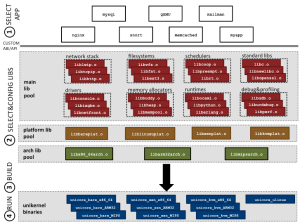This blog post was written by Dr. Felipe Huici, Chief Researcher, Systems and Machine Learning Group, at NEC Laboratories Europe
 The team at NEC Laboratories Europe spent quite a bit of time over the last few years developing unikernels – specialized virtual machine images targeting specific applications. This technology is fascinating to us because of its fantastic performance benefits: tiny memory footprints (hundreds of KBs or a few MBs), boot times compared to those of processes or throughput in the range of 10-40 Gb/s, among many other attributes. Specific metrics can be found in these articles: “My VM is Lighter (and Safer) than your Container,†“Unikernels Everywhere: The Case for Elastic CDNs,†and “ClickOS and the Art of Network Function Virtualization.â€
The potential of unikernels is great (as you can see from the work above), but there hasn’t been a massive adoption of unikernels. Why? Development time. For example, developing Minipython, a MicroPython unikernel, took the better part of three months to put together and test. ClickOS, a unikernel for NFV, was the result of a couple of years of work.
What’s particularly bad about this development model, besides the considerable time spent, is each unikernel is basically a “throwaway.†Every time we want to create a new unikernel targeting a different application, developers have to start from scratch. Essentially, there is a lack of shared research and development when it comes to building unikernels.
We (at NEC) wanted to change this, so we started to re-use the work and created a separate repo consisting of a “toolstack†that would contain functionality useful to multiple unikernels — mostly platform-independent versions of newlib and lwip (a C library and network stack intended for embedded systems).
This got us thinking that we should take our work to a much bigger level. We asked the question: Wouldn’t it be great to be able to very quickly choose, perhaps from a menu, the bits of functionality that we want for an unikernel, and to have a system automatically build all of these pieces together into a working image? It would also be great if we could choose multiple platforms (e.g., Xen, KVM, bare metal) without having to do additional work for each of them.
The result of that thought process is Unikraft. Unikraft decomposes operating systems into elementary pieces called libraries (e.g., schedulers, memory allocators, drivers, filesystems, network stacks, etc.) that users can then pick and choose from, using a menu to quickly build images tailored to the needs of specific applications. In greater detail, Unikraft consists of two basic components (see Figure 1):
- Library pools contain libraries that the user of Unikraft can select from to create the unikernel. From the bottom up, library pools are organized into (1) the architecture library tool, containing libraries specific to a computer architecture (e.g., x86_64, ARM32 or MIPS); (2) the platform tool, where target platforms can be Xen, KVM, bare metal (i.e. no virtualization), user-space Linux and potentially even containers; and (3) the main library pool, containing a rich set of functionality to build the unikernel. This last library includes drivers (both virtual such as netback/netfront and physical such as ixgbe), filesystems, memory allocators, schedulers, network stacks, standard libs (e.g. libc, openssl, etc.), and runtimes (e.g. a Python interpreter and debugging and profiling tools). These pools of libraries constitute a codebase for creating unikernels. As shown, a library can be relatively large (e.g libc) or quite small (a scheduler), which allows for customization for the unikernel.
- The Unikraft build tool is in charge of compiling the application and the selected libraries together to create a binary for a specific platform and architecture (e.g., Xen on x86_64). The tool is currently inspired by Linux’s KCONFIG system and consists of a set of Makefiles. It allows users to select libraries, to configure them, and to warn them when library dependencies are not met. In addition, the tool can also simultaneously generate binaries for multiple platforms.

Figure 1. Unikraft architecture.
Getting Involved
We are very excited about the recent open source release of Unikraft as a Xen Project Foundation incubator project.  The Xen Project is a part of the Linux Foundation umbrella. We welcome developers willing to help improve Unikraft. Whether you’re interested in particular applications, programming languages, platforms, architectures or OS primitive. We are more than happy to build and receive contributions from the community. To get you started, here are a number of available resources:
- Developer’s guide: available in the docs directory of the Unikraft sources at http://xenbits.xen.org/gitweb/?p=unikraft/unikraft.git .
- Developer’s wiki listing general information useful for developers including which items the core team is working on and ideas about possible contributions. https://wiki.xenproject.org/wiki/Category:Unicore_Devel
- Website: The main Unikraft website. https://www.xenproject.org/developers/teams/unikraft.html
- NEC’s Unikraft Website: http://sysml.neclab.eu/projects/unikraft/
- Mailing list: we share the mailing list with MiniOS, please subscribe here: https://lists.xenproject.org/cgi-bin/mailman/listinfo/minios-devel .
Please don’t be shy about getting in touch with us, we would be more than happy to answer any questions you may have. You can reach the core Unikraft development team at sysml@listserv.neclab.eu .

